schwartzy18510
New member
- Joined
- Jul 20, 2019
- Messages
- 3
- Tractor
- Craftsman YTS 3000
Hello all! As a dedicated DIYer, Google has led me here multiple times over the years when dealing with small engine repairs. I finally joined the forums today to ask for input on a situation regarding crankcase pressure which has me stumped. I recently purchased a Deines 1800 KT ZRT 60" front-deck mower with about 1,300 hours on it. The original 18 HP Kohler motor was replaced by the previous owner in 2016 with a 20 HP Honda GX620 knock-off. I'm told the new V-twin OHV engine has less than 20 hours on it. Prior to purchasing the mower, I knew the engine leaked some oil. The previous owner disclosed this and said he thought it possible the engine simply hadn't been broken in yet.
After bringing the mower home, cleaning the engine up, and chasing my tail with attempting to resolve a half-dozen oil leaks, I identified what I believed to be the underlying cause crankcase pressure building in the block. I then verified the operation of the crankcase breather valve and hose and replaced both head gaskets, as inspection revealed that one of them was blown between the oil return passageway from the cylinder head to the combustion chamber. Both pistons looked fine when I had the heads off, and the cross-hatching was still quite visible on the cylinder walls, with no evidence of scoring.
The oil leak issue is now lessened, but two of the original four leaks still remain (oil dipstick tube, crankcase gasket). There is no smoke of any kind coming from the exhaust like you would expect with worn piston rings. And with an engine this new, worn rings would seem somewhat unlikely anyway. My question is whether gasket leaks caused by high crankcase pressure from blow-by originating from a blown head gasket could still be seeping oil even after the underlying blow-by issue was resolved. Basically I'm trying to figure out whether I'll need to pull the engine and perform a piston ring job, or whether replacing the crankcase gasket and oil dipstick is all that's needed.
TROUBLESHOOTING
I knew the tractor had been poorly maintained when I purchased it, and immediately went about bringing its maintenance schedule up-to-date. The largest concern was multiple oil leaks, which I've listed in order of worst first:
I then moved on to suspecting blown head gaskets and/or worn piston rings creating a large amount of blow-by, resulting in increased crankcase pressure. I don't have a cylinder leak-down tester, and since the mating surfaces between the heads and the block were indicating gasket leaks anyway, I simply tore it down to the block to see what I could find. In the course of the tear-down I found that in each case, two of the four bolts for both cylinder heads were only finger-tight. Both spark plugs were a little loose as well. The head gasket on cylinder #1 looked fine, but there was visible oil residue marking the block mating surface between the combustion chamber and the oil return passageway leading back to the crankcase. This happened to be on the side that both head bolts were loose.
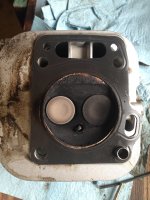
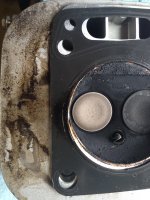
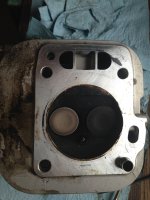
The head gasket on cylinder #2 was blown between the oil return passageway to the crankcase and the outside edge of the gasket, with blackened oil residue indicating there was oil leaking into the combustion chamber as well. Again, this was the side on which both head bolts were loose. I was happy to find the blown gasket on cylinder #2, as I was hoping that combustion leaking into the oil return passageway was the cause of my blow-by and not simply a symptom of it. I cleaned up both surfaces of the combustion chambers, installed new head gaskets, and torqued to spec.
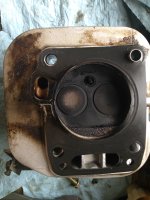

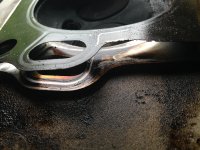
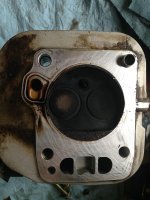
In the course of the tear-down I also performed the following:
This would be a perfect time for a leak-down test, but I don't have a tester and am reticent to spend $40 for a Harbor Freight-quality unit which has mixed reviews. None of the local auto repair stores loan them out. I can attempt to measure blow-by using a home-made manometer and interpreting results, but I don't have factory specs to compare my findings to so I'm not sure how useful that would be.
I did test compression on the #2 cylinder this afternoon, but skipped the #1 cylinder as accessing it requires the removal of the starter and some other assorted engine components. I performed the compression test with the choke and throttle both wide open. Engine specs call for a range of 85-114 PSI at 500 RPM. Compression test results for cylinder #2:
After bringing the mower home, cleaning the engine up, and chasing my tail with attempting to resolve a half-dozen oil leaks, I identified what I believed to be the underlying cause crankcase pressure building in the block. I then verified the operation of the crankcase breather valve and hose and replaced both head gaskets, as inspection revealed that one of them was blown between the oil return passageway from the cylinder head to the combustion chamber. Both pistons looked fine when I had the heads off, and the cross-hatching was still quite visible on the cylinder walls, with no evidence of scoring.
The oil leak issue is now lessened, but two of the original four leaks still remain (oil dipstick tube, crankcase gasket). There is no smoke of any kind coming from the exhaust like you would expect with worn piston rings. And with an engine this new, worn rings would seem somewhat unlikely anyway. My question is whether gasket leaks caused by high crankcase pressure from blow-by originating from a blown head gasket could still be seeping oil even after the underlying blow-by issue was resolved. Basically I'm trying to figure out whether I'll need to pull the engine and perform a piston ring job, or whether replacing the crankcase gasket and oil dipstick is all that's needed.
TROUBLESHOOTING
I knew the tractor had been poorly maintained when I purchased it, and immediately went about bringing its maintenance schedule up-to-date. The largest concern was multiple oil leaks, which I've listed in order of worst first:
- Oil Dipstick
- Remote Oil Cooler Hose Connections
- Cylinder #2 Head Gasket
- Cylinder #1 Head Gasket
I then moved on to suspecting blown head gaskets and/or worn piston rings creating a large amount of blow-by, resulting in increased crankcase pressure. I don't have a cylinder leak-down tester, and since the mating surfaces between the heads and the block were indicating gasket leaks anyway, I simply tore it down to the block to see what I could find. In the course of the tear-down I found that in each case, two of the four bolts for both cylinder heads were only finger-tight. Both spark plugs were a little loose as well. The head gasket on cylinder #1 looked fine, but there was visible oil residue marking the block mating surface between the combustion chamber and the oil return passageway leading back to the crankcase. This happened to be on the side that both head bolts were loose.



The head gasket on cylinder #2 was blown between the oil return passageway to the crankcase and the outside edge of the gasket, with blackened oil residue indicating there was oil leaking into the combustion chamber as well. Again, this was the side on which both head bolts were loose. I was happy to find the blown gasket on cylinder #2, as I was hoping that combustion leaking into the oil return passageway was the cause of my blow-by and not simply a symptom of it. I cleaned up both surfaces of the combustion chambers, installed new head gaskets, and torqued to spec.




In the course of the tear-down I also performed the following:
- Removed the breather valve cover and inspected / cleaned the breather valve.
- Reset coil-to-flywheel gap to spec, as it was off by over .010".
- Rotated engine to TDC and reset valve lash to spec (Intake .015", Exhaust .020").
- Performed a comprehensive cleaning of the carburetor.
- Checked the oil it was not overfull, nor did it smell of gasoline.
This would be a perfect time for a leak-down test, but I don't have a tester and am reticent to spend $40 for a Harbor Freight-quality unit which has mixed reviews. None of the local auto repair stores loan them out. I can attempt to measure blow-by using a home-made manometer and interpreting results, but I don't have factory specs to compare my findings to so I'm not sure how useful that would be.
I did test compression on the #2 cylinder this afternoon, but skipped the #1 cylinder as accessing it requires the removal of the starter and some other assorted engine components. I performed the compression test with the choke and throttle both wide open. Engine specs call for a range of 85-114 PSI at 500 RPM. Compression test results for cylinder #2:
- Cold - 40 PSI
- Cold w/oil added via spark plug hole - 40 PSI
- Hot - 52 PSI
- Hot w/engine running - 120 PSI
- Is it likely that the two remaining oil leaks are simply the result of the previous blow-by that has since been resolved?
- I've read that a failed dipstick seal / breather valve can cause high crankcase pressure. Can a bad oil dipstick seal and crankcase cover gasket actually create crankcase pressure?
- I've read that out-of-spec valve lash that is too wide will lead to high compression due to a failure of the compression release feature to work. Does this seem likely?
- Some engines actually intentionally utilize crankcase pressure to, say, activate a vacuum-operated fuel pump. The fuel pump on this engine does indeed operate on vacuum pulses from the crankcase. Is some amount of crankcase pressure normal on these engine types for this reason?
- I believe this engine may have been sitting for up to a year. Is it possible that the rings are simply stuck and are not standing proud off of the pistons? Should I try a treatment with Marvel Mystery Oil to see if it will help?
